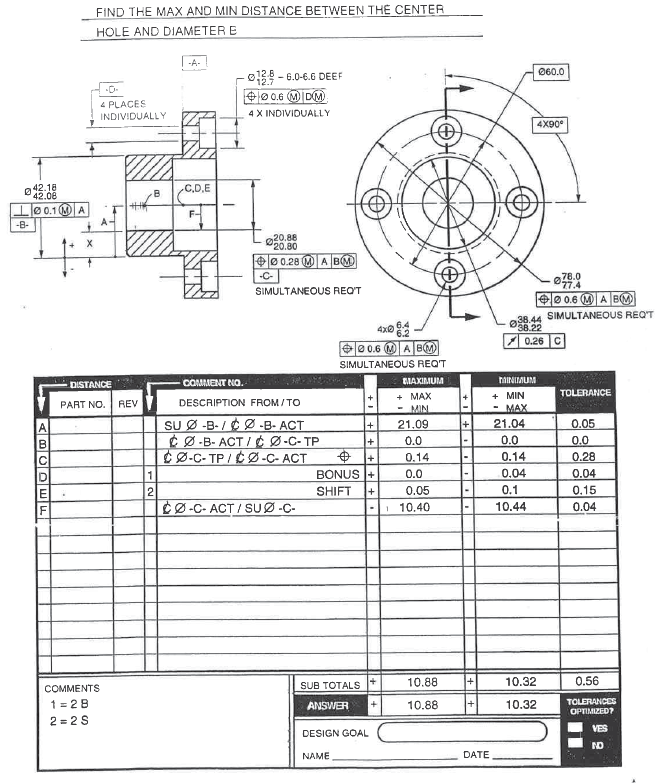Again I will assume perfect form and orientation for all features and axes, except as noted.
greenimi said:
Are you sure that if only "4 X INDIVIDUALLY" AND "4 PLACES INDIVIDUALLY" are removed from the problem statement/ drawing then the "new values" are the ones you indicated in your above quote?
I stand by my answers of X_min = 60 + 12.1 - 2 * 12.8 = 46.5 and X_max = 60 - 12.1 = 47.9. I don't know why pmarc has X_min = 46.6.
greenimi said:
And to follow up on my own question, what would be the new values (X min and X max) if D is RFS?
Here are my calculations:
[pre]
60 / 2 % center to through-hole true position
+ (6.2 - 0.6) / 2 % center to outer edge of through-hole position tolerance boundary
- 6.4 / 2 % center to datum axis D
+ (12.7 - 0.6) / 2 % center to outer edge of counterbore position tolerance boundary
- 12.8 % center to inner edge of counterbore
* 2 % inner edge of counterbore to inner edge of counterbore
= 45.7 % X_min
60 / 2 % center to through-hole true position
- (6.2 - 0.6) / 2 % center to inner edge of through-hole position tolerance boundary
+ 6.4 / 2 % center to datum axis D
- (12.7 - 0.6) / 2 % center to inner edge of counterbore position tolerance boundary
+ 0 % center to inner edge of counterbore
* 2 % inner edge of counterbore to inner edge of counterbore
= 48.7 % X_max
[/pre]
I don't know why pmarc has X_min = 47.4.
Note that the assumption of perfect form is important here. Non-cylindrical through-holes would allow the answers to remain arbitrarily close to 45.5 and 48.9.
aniiben said:
My values (Xmin: 45.7 and X max. : 48.7) are closer to pylfrm’s values ( Xmin: 45.5, Xmax: 48.9), but nevertheless still a difference.
0.2 would be the differences between pylfrm’s values and mine.
As pmarc said, it is because you did not include datum shift. Note that your answers match mine for greenimi's RMB scenario.
pmarc said:
Also, assumptions would not have to be made, in my opinion, if the positional callout for counterbores was referencing |A|D(M)|. In that case correct answers would be Xmin = 45.5 and Xmax = 48.9, as given by pylfrm.
I disagree here. Referencing A as primary changes the MMB of datum features D from diameter 6.2 to diameter 5.6, making the answers 44.9 and 49.5. This is actually the result shown in the PDF attached in the original post.
pylfrm


